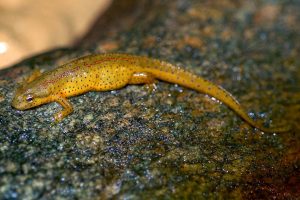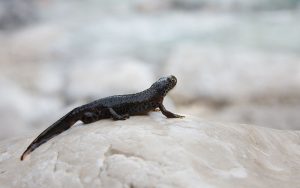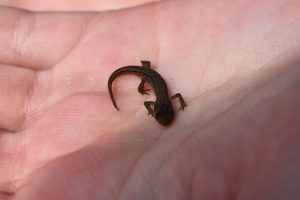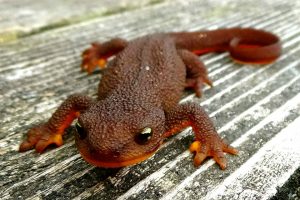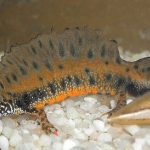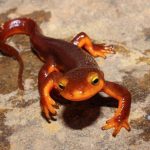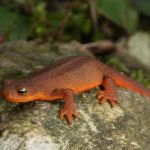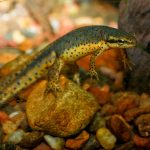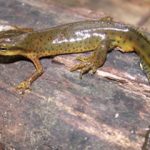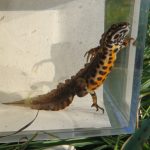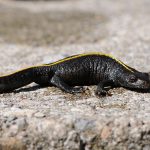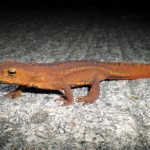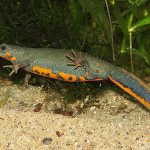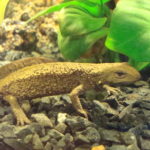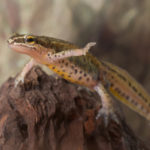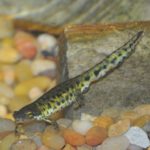Newts
Newts are salamanders belonging to the Pleurodelinae subfamily. They have four equal limbs and a tail. Although similar to lizards in appearance, they are salamanders instead. Newts have an extraordinary ability to regenerate their lost organs and parts like hearts, intestines, spinal cords, eyes, lower and upper jaws. They are native to North America, North Africa, Asia, and Europe.
Calotriton or European Brook Newts |
||
| Montseny Brook Newt | Pyrenean Newt / Pyrenean Brook Salamander | |
Neurergus or Spotted Newts |
||
| Yellow-spotted / Lake Urmia Newt | Kaiser’s spotted / Emper or spotted / Luristan Newt | Kurdistan Spotted Newt |
| Strauch’s Spotted/Anatolian Newt Subspecies: N. s. strauchi , N. s. barani | ||
Pleurodeles or Ribbed Newts |
||
| Algerian Ribbed Newt | Edough Ribbed / Poiret’s Newt | Iberian Ribbed / Spanish Ribbed Newt / Gallipato |
Cynops or Fire / Fire Belly Newts (Hypselotriton arguably) |
||
| Chenggong Fire Belly / Blue-tailed Fire Belly Newt | Blue-tailed Fire Belly Newt / Chuxiong Fire-bellied | Japanese Sword-tail Newt |
| Fuding Fire Belly Newt | Chinese Fire Belly Newt | Dayang Fire Belly / Dayang Newt |
| Japanese Fire Belly Newt Subspecies: Hiroshima race, Tamba or Sasayama race, Atsumi race, Kanto race,Touhoku race, Intermediate race | ||
| Yunnan Lake / Wolterstorff’s Newt | ||
Notophthalmus or Eastern / North American Newts |
||
| Black-spotted/Texas Newt | Striped Newt | |
| Red-spotted/Eastern Newt Subspecies: Red-spotted Newt, Broken-striped Newt, Central Newt, Peninsula Newt | ||
Taricha or Pacific / Roughskin / Western Newt |
||
| Red-bellied Newt | Sierra Newt | |
| Rough-skinned/roughskin Newt Subspecies: Rough-skinned Newt, Crater Lake / Mazama Newt | ||
| California or Orange-bellied Newt | ||
Echinotriton or Spiny or Mountain Newts |
||
| Anderson’s / Anderson’s Crocodile / Ryukyu Spiny / Japanese Warty Newt | Chinhai Spiny Newt | Echinotriton maxiquadratus |
Ommatotriton or Banded Newts |
||
| Ommatotriton nesterovi | Northern Banded Newt | Southern Banded Newt |
Triturus |
||
| Anatolian Crested Newt | Buresh’s or Balkan Crested Newt | Persian or Southern Newt |
| Alpine crested / Italian Newt | Great Crested / Northern Crested / Warty Newt | Danube / Danube Crested Newt |
| Macedonian Crested Newt | Marbled Newt | Pygmy Marbled / Southern Newt |
Ichthyosaur |
||
| Alpine Newt | ||
Pachytriton or Chinese or Paddle – tail Newts |
||
| Pachytriton archospotus | Spotted Paddle-tail Newt | Pachytriton changi |
| Pachytriton feii | Pachytriton granulosus | Yaoshan Stout / Paddletail Newt |
| Pachytriton moi | Pachytriton wuguanfui | Pachytriton xanthospilos |
Tylototriton or Knobby / Crocodile Newts |
||
| Angular-headed Newt | Black Knobby Newt | Tylototriton broadoridgus |
| Tylototriton dabienicus | Hainan Knobby Newt | Tylototriton himalayanus |
| Kweichow/ Red-tailed Knobby Newt | Ywangan Crocodile Newt | Laos Knobby Newt |
| Tylototriton Panhai | Southern Sichuan Crocodile Newt | Tylototriton shanorum |
| Mandarin /Emperor Newt / Mandarin Salamaner | Taliang Knobby Newt | Chiang Mai Crocodile Newt |
| Himalayan Newt | Vietnamese Knobby / Vietnamese Crocodile Newt | Wenxian Knobby Salamander / Newt |
| Tiannan Crocodile Newt | Ziegler’s Crocodile Newt | |
Lissotriton |
||
| Boscá’s/ Iberian Newt | Greek Newt | |
| Palmate Newt Subspecies: L. h. helveticus, L. h. punctillatus, L. h. alonsoi | ||
| Italian Newt | Lissotriton kosswigi | Caucasian Smooth Newt |
| Lissotriton maltzani | Southern Smooth Newt | Carpathian / Montadon’s Newt |
| Smooth / Common Newt (Lissotriton vulgaris) Subspecies L. v. vulgaris | ||
Paramesotriton or Asian Warty / Warty Newts |
||
| Paramesotriton aurantius | Spot-tailed Warty Newt | Chinese Warty Newt |
| Tam Dao / Vietnamese Salamander | Wanggao Warty Newt | Guangxi Warty Newt |
| Hong Kong Warty / Hong Kong Newt | Unterstein’s / Spotless Snout / Spotless Smooth Warty / Paddletail / Zhao Ermi’s Smooth Warty Newt | Paramesotriton longliensis |
| Paramesotriton maolanensis | Paramesotriton qixilingensis | Paramesotriton wulingensis |
| Yunwu Warty Newt | Zhijin Warty Newt | |
Euproctus or European Mountain Salamanders |
||
| Corsican Brook Salamander / Corsican Mountain Newt | Sardinian Mountain Newt / Sardinian Brook Salamander | |
Habitat: Where Do Newts Live
Newts live in humid lands with rocks, logs, and holes
nearby. Since they become aquatic during reproduction, some species prefer to
stay in slow-moving streams, otherwise pond, mountain streams, even flooded
meadows, marshes, and lakes are good for them.
Diet: What Do They Eat
During their life on land, adult newts consume small
invertebrates, eggs of amphibians, worms, slugs, and insects while in the water they
usually have aquatic insect larvae, shrimps, and tadpoles. Baby newts or larvae
prefer aquatic insect larvae and tiny shrimps.
Reproduction and Lifecycle
The breeding season mostly start from June and last up to
July. Male newts deposit their sperm pouch known as spermatophore on some
floating objects like leaves in the water. Then
through some courtship periods, (the style defers from one species to another)
the male lures the female to accept the sperm pouch inside their cloaca (an
internal part leading directly to urinary, intestinal, and reproductive tracts).
Some species use their pheromones for attracting potential mates.
Post mating, female newts lay hundreds of eggs and then find
aquatic plants to attach the eggs with. The eggs have a gel-like exterior.
Sometimes, female newts coil themselves around the eggs for protecting them.
A few newt species are known to have an initial tadpole
phase, where they live as an aquatic species with gills and a fish-like
tail. Some of them remain aquatic
throughout their juvenile phase.
Following the tadpole phase, a few species go through
the eft phase. This is where they become terrestrial larvae. Some species which
are aquatic while they are inside the eggs and during the adulthood, might be terrestrial for this phase only.
Most adult newts with their legs and tails are flexible in
land and water at the same time.
Are They Poisonous
Some newts are known to produce toxins to defend themselves
from predators. For humans, newts are poisonous if ingested. Although some newts are popularly kept as pets, thoroughly washing of hands after
handling them is recommended as they carry salmonella bacteria.
Threats and Predators
Fishes, herons, snakes, foxes, prey on newts. Frogs and
fishes eat newt eggs as well.
Interesting Facts
- Japanese fire belly newt can reproduce their
lens eighteen times, within a span of sixteen years. - Yunnan lake newt has recently gone extinct.
- The name newt is believed to have come as a result
of a dialectical difference of the word eft. - In historical literature, newts are called Tritones,
so are in Greek, Romanian, and Russian language. - Newts cannot hear, neither can they produce any
sound. - Japanese fire belly newts, paddletail newts, Chinese
warty newts, and eastern newts are popular pet options.
